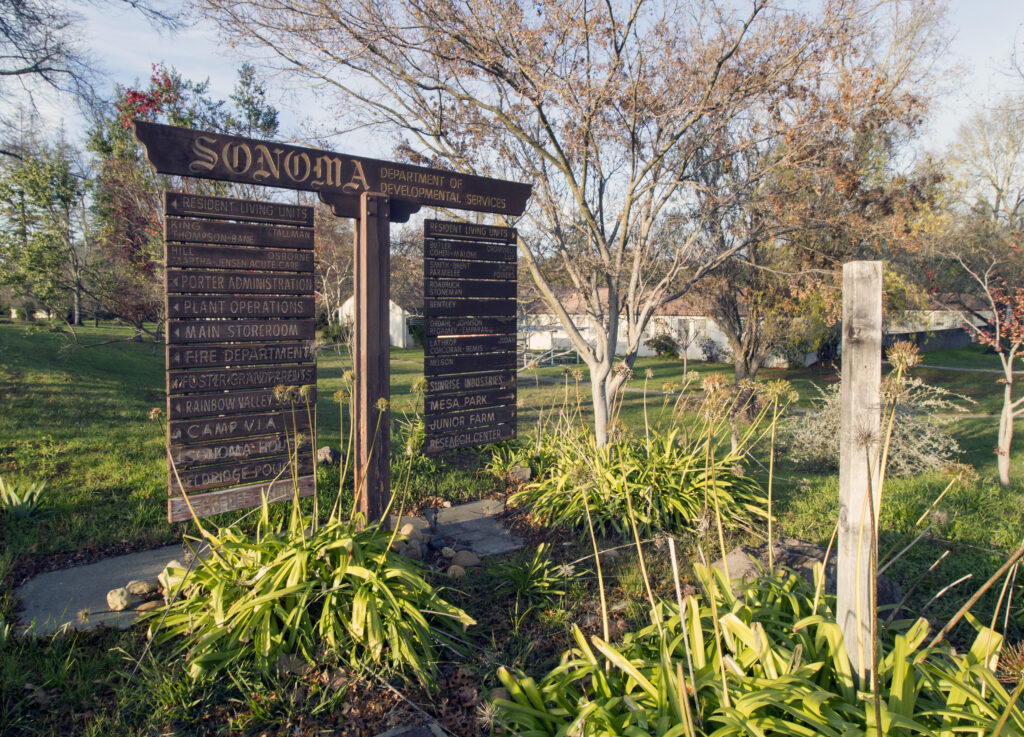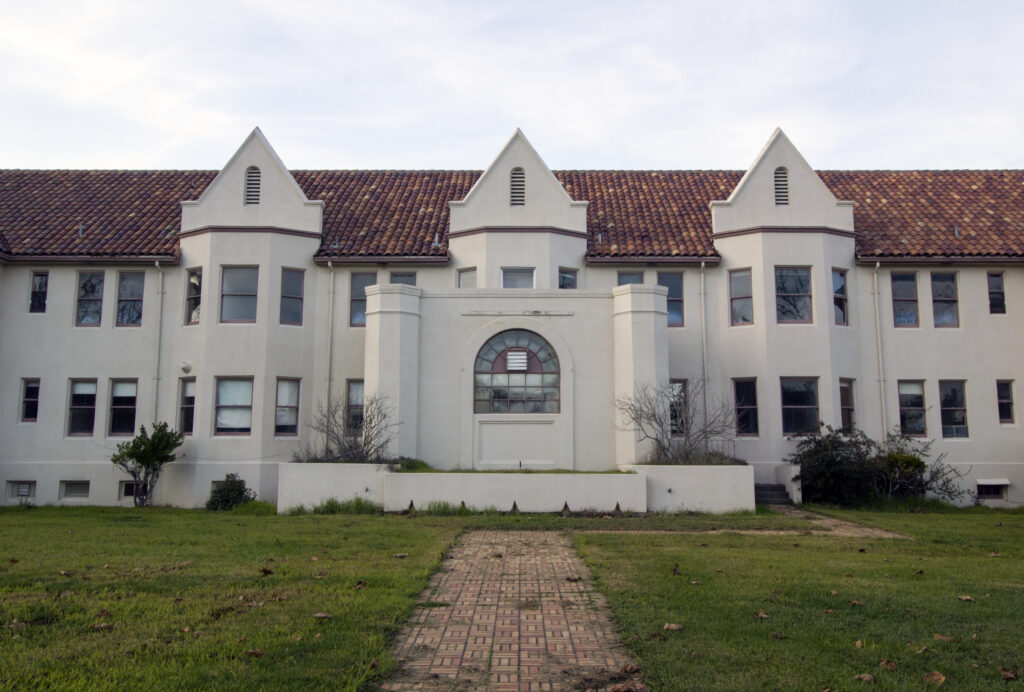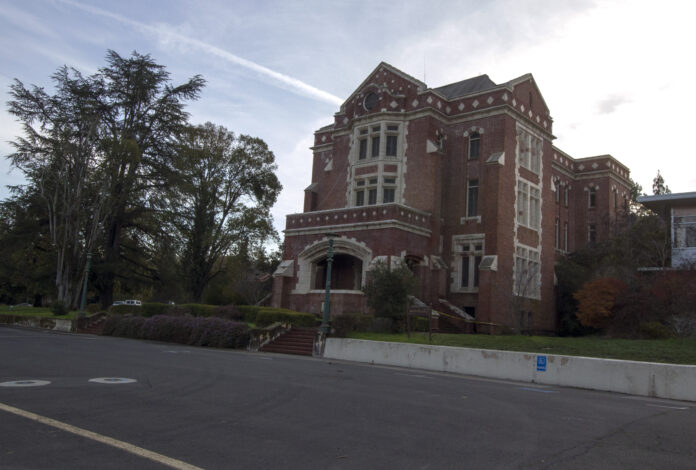Since the state announced plans to close the Sonoma Developmental Center several years ago, the potential of the sprawling property has captured the imaginations of Sonoma County residents.
The 900-acre plot of land near Glen Ellen is seen by many as a rare opportunity to address worsening problems—among them, a lack of affordable housing in the midst of a worsening climate crisis and soaring inequality.
That’s not to say the SDC is an entirely blank slate. It has plenty of history—good and bad.
Nestled between the Sonoma Valley Regional Park and Jack London State Historic Park, the center of the property is populated with buildings spanning the past century-plus.
The brick-clad “Main Building,” constructed in 1908 after its predecessor was damaged in the 1906 earthquake, stands at the end of a long drive dotted with pollarded trees and flanked by a variety of vacant buildings.
The SDC was one of numerous state-run “developmental centers” sprinkled throughout California. For decades, the campus served as a medical and residential center for people with mental illness and various medical conditions. At the height of its use, the SDC was the county’s largest employer and housed thousands of residents, who were offered job training and access to farms and orchards.
However, the track record wasn’t all positive.
“Between 1909 and 1952, [a] total of 5,530 men and women were involuntarily sterilized at Sonoma State Home, more than at any other state hospital or at any single facility in the nation,” says the SDC planning website. The practice was legal in California until 1979.


On a late-December weekend tour, the campus was deserted except for a few dog walkers wandering the grounds, some of whom headed off to explore the hills above the main campus.
In 2015, the state announced plans to close the developmental center. It was officially closed in late 2018 after all residents were relocated. Now, the state wants to sell the now-surplus land.
The state has paid to maintain the buildings, but most of them are no longer used.
To residents of the surrounding areas—and, presumably, real estate developers—the next chapter in the history of the SDC represents enormous potential. In an age of great systemic problems, the SDC looks like a relatively blank slate which could be used to address some local societal problems.
However, the vision considered by planners has been limited since 2019 when the state legislature passed a bill defining the process to plan the future use of the SDC. Although the property is state-owned, as a form of courtesy, the state would collaborate with Sonoma County on a plan.
Per the state law, the plan needs to include market rate and affordable housing; preserve open space around the 180-acre developed core; and, likely the most unpopular restriction, be mindful of the “economic feasibility of [a] future development.” In other words, the state wants to sell the property to a private party and the plan should allow the future owner to make money.
The baked-in costs of redeveloping the SDC make the last requirement a significant constraint on any possible plan. All told, the cost of tearing down buildings and remediating the property is expected to cost the future owner $100 million or more. As a result, if the new owner intends to profit on the project, they’ll want to build as many market rate—read: expensive—units and commercial buildings as possible.
The three alternatives released in November call for between 990 and 1,290 units of housing, 75% of which would be market rate. Almost immediately, the proposals were met with frustration and calls for a “4th alternative.” One common concern is that the total number of housing units is too high and the portion of affordable units is too low.
According to the latest Regional Housing Needs Assessment released by the Bay Area planning agency last month, Sonoma County needs to construct 3,881 affordable housing units in the unincorporated county for people making less than a Moderate Income between 2023 and 2031. A Moderate Income in Sonoma County is currently defined as less than $123,950 for a family of four. Of the total required, 1,036 units need to serve extremely low-income residents, currently defined as a family of four that makes less than $34,900 per year.
Facing that massive need for affordable housing, it might be tempting to build as many new units on the property as possible. However, many have concerns about evacuating a large number of residents from the property along Highway 12 during a fire, and about the long-term transportation and climate impacts of building a significant housing development far from any existing city.
On Tuesday, Jan. 25, the Sonoma County Board of Supervisors will consider the three proposals on the table. It remains unclear whether the Supervisors will push for a fourth alternative.


The Bohemian took a tour of the property in December with two of the many people following the SDC planning process.
Bonnie Brown, a Sonoma Valley resident, advocates for reusing as many of the existing buildings on the property as possible. Brown argues that this approach would save a developer money and be more environmentally-friendly, since construction is a carbon-intensive process.
Tracy Salcedo, the Bohemian’s second tour guide, prioritizes maintaining the open space surrounding the SDC’s core. The author of numerous hiking guides, Salcedo sees the potential of having hundreds of additional acres of open space in addition to the nearby Jack London State Park.
“What I do see personally as being important, and I think will always be important, is preservation of the open space, because there has not been a time in human history when it hasn’t been important for us to be able to access wildlands for us to make that connection,” Salcedo said.
Ultimately, Salcedo, who has written about the SDC planning process for publications including the Kenwood Press, sees the process as a balancing act. Different advocates are excited by different aspects of the property today, and the needs of future generations are always in flux.
The trick will be for the numerous groups to come together around a shared vision, a process Salcedo already sees happening. Whether they can break free of the financial constraints set by the 2019 state law is another question.











